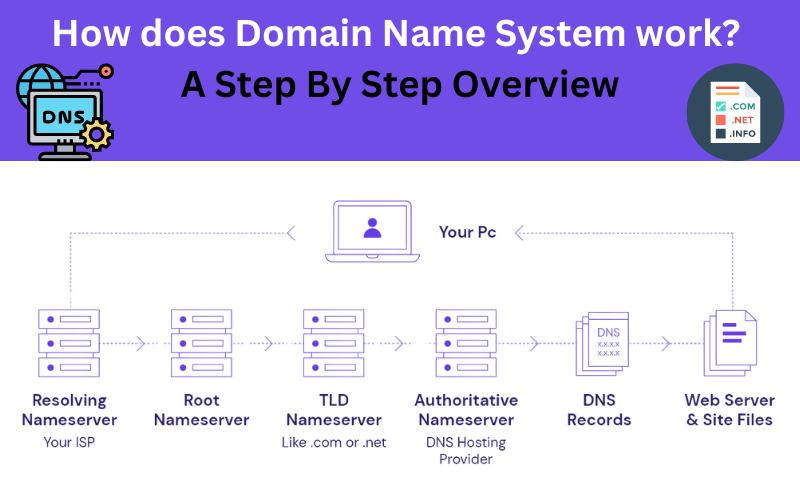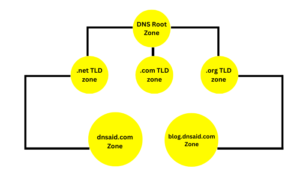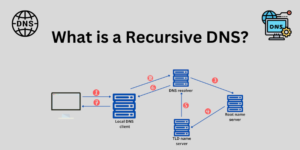DNS stands for Domain Name System. DNS works like a phonebook for the internet. We access information online with domain names like amazon.com and espn.com. We use web browsers like Chrome, Opera, Bing, and others to interact with internet protocols or IP addresses. The DNS, or Domain Name System, then translates domain names like amazon.com or others into IP addresses like 192.168.1.1. This makes it easier for users to access websites using memorable names instead of numerical addresses. DNS helps route your request to the correct server hosting the website. Without DNS, you would need to remember the IP address of each site you want to visit. DNS servers can be public or private. Public DNS servers are managed by ISPs or organizations like Google and Cloudflare. Private DNS servers are often used within organizations for internal networks. DNS is crucial for the functionality of the internet.
How does Domain Name System work? A Step By Step Overview

DNS works through a process called DNS resolution. Here is a step by step guide:
- User Requests:
- You enter a domain name (e.g., www.example.com) into your browser.
- DNS Query:
- Your browser sends a DNS query to a DNS resolver (often provided by your ISP or a public DNS service).
- DNS Resolver:
- The DNS resolver checks its cache for a recent answer to your query.
- If not found, it proceeds to query other DNS servers.
- Root DNS Servers:
- The resolver queries one of the root DNS servers.
- Root servers respond with the address of a TLD (top-level domain) DNS server (e.g., for.com domains).
- TLD DNS Servers:
- The resolver queries the TLD DNS server.
- The TLD server responds with the address of the authoritative DNS server for the specific domain.
- Authoritative DNS Server:
- The resolver queries the authoritative DNS server for the domain (e.g., example.com).
- The authoritative server responds with the IP address of the domain’s web server.
- IP address returned:
- The resolver returns the IP address to your browser.
- Website Accessed:
- Your browser uses the IP address to request the website from the appropriate server.
- Caching:
- The IP address is cached by your browser and DNS resolver for future requests to speed up the process.
This process happens quickly, usually in milliseconds, to connect you to the website seamlessly.
How Many DNS servers involved in loading a webpage?
There are four DNS servers involved in loading a webpage.
DNS Resolver (Recursor):
- Role: The DNS resolver is the first stop in the DNS query process.
- Function: When you type a domain name (e.g., www.example.com) into your browser, your browser sends a request to the DNS resolver. This resolver is usually provided by your Internet Service Provider (ISP) or a public DNS service like Google DNS (8.8.8.8) or Cloudflare DNS (1.1.1.1).
- Process: The resolver’s job is to find the IP address associated with the domain name. If it has the answer cached from a previous query, it returns the IP address immediately. If not, it starts querying other DNS servers.
Root Nameserver:
- Role: The root nameserver is the first step in translating the domain name into an IP address when the DNS resolver doesn’t have the information cached.
- Function: The root nameserver doesn’t know the exact IP address of the domain but knows where to find the TLD nameservers.
- Process: The DNS resolver sends a query to the root nameserver asking for the IP address of the domain. The root nameserver responds with the address of the appropriate TLD nameserver based on the domain extension (e.g.,.com,.org).
TLD Nameserver:
- Role: The TLD (Top-Level Domain) nameserver takes the query to the next level by narrowing it down to the specific domain.
- Function: It knows where the authoritative nameservers for the specific domain are located.
- Process: The DNS resolver then queries the TLD nameserver (e.g., the.com nameserver for www.example.com). The TLD nameserver responds with the IP address of the authoritative nameserver for that domain (e.g., example.com).
Authoritative Nameserver:
- Role: The authoritative nameserver is the final source of truth for the domain name’s IP address.
- Function: It holds the actual DNS records for the domain (A records, MX records, etc.).
- Process: The DNS resolver queries the authoritative nameserver for the specific domain (e.g., www.example.com). The authoritative nameserver responds with the IP address of the web server hosting the domain. This IP address is then returned to your browser.
What Is Authoritative DNS server And recursive DNS resolver?
Authoritative DNS Server
Role:
- The authoritative DNS server is the definitive source for DNS records for a specific domain.
Function:
- It stores and provides the actual DNS records (such as A records, MX records, and CNAME records) for a domain. These records include the IP address of the domain’s web server, mail servers, and other essential services.
Operation:
- When a DNS query reaches the authoritative DNS server, it responds with the precise information contained in its records. For example, if asked for the IP address of www.example.com, it will provide the actual IP address (e.g., 192.0.2.1).
Responsibility:
- It’s managed by the domain owner or their DNS hosting provider and is responsible for the accuracy of the DNS information for that domain.
Example:
- If you own the domain example.com, you (or your DNS hosting provider) would configure the authoritative DNS server to respond with the correct IP addresses and other DNS records for your domain.
Recursive DNS Resolver

Role:
- The recursive DNS resolver acts as an intermediary that queries other DNS servers to find the answer to a DNS query on behalf of the client (e.g., your web browser).
Function:
- It takes the initial query from the client and performs the necessary steps to resolve the domain name into an IP address by querying other DNS servers in a hierarchical manner. This includes contacting root servers, TLD servers, and authoritative servers as needed.
Operation:
- When you enter a domain name into your browser, the browser sends the query to a recursive resolver. The resolver checks its cache first to see if it has a recent answer. If not, it queries the root nameserver, then the TLD nameserver, and finally the authoritative nameserver to get the required information.
Responsibility:
- It’s usually managed by ISPs or public DNS service providers (e.g., Google Public DNS, Cloudflare DNS) and is responsible for efficiently resolving DNS queries from clients.
Example:
- When you type www.example.com into your browser, your device sends the query to a recursive DNS resolver. This resolver then finds the IP address by querying the necessary DNS servers and returns the IP address to your browser.
How Mnay Steps in a DNS Lookup?
Step 1: User Query
- A user types ‘example.com’ into a web browser.
- The query travels to the Internet and is received by a DNS recursive resolver.
Step 2: Query the root nameserver
- The DNS recursive resolver queries a DNS root nameserver (represented by a dot.).
Step 3: Response from the Root Nameserver
- The root server responds to the resolver with the address of a Top Level Domain (TLD) DNS server, such as.com or.net.
- For our example.com query, it directs the resolver to the.com TLD server.
Step 4: Query the TLD Nameserver
- The resolver then makes a request to the.com TLD nameserver.
Step 5: Response from the TLD Nameserver
- The TLD server responds with the IP address of the domain’s authoritative nameserver, for example.com.
Step 6: Query the domain’s authoritative nameserver
- The recursive resolver sends a query to the domain’s authoritative nameserver.
Step 7: IP Address Returned
- The authoritative nameserver returns the IP address, for example.com, to the resolver.
Step 8: Response to the Web Browser
- The DNS resolver responds to the web browser with the IP address of the domain requested initially.
Completing the Web Page Request
Once the DNS lookup process has provided the IP address, for example, example.com, the web browser can proceed to load the web page:
Step 9: HTTP Request
- The browser makes an HTTP request to the obtained IP address.
Step 10: Web Page Returned
- The server at the IP address returns the webpage to be rendered in the browser.
What Are The Key Functions of a DNS Resolver?
Receiving Queries:
When a user enters a domain name in a browser, the query is sent to a DNS resolver. This query is the starting point for finding the corresponding IP address.
Querying DNS servers:
If the DNS resolver does not have the answer cached, it begins a process of querying a sequence of DNS servers to find the necessary information. This typically involves contacting:
- Root DNS servers
- Top-Level Domain (TLD) DNS servers
- Authoritative DNS servers
Caching Responses:
To improve efficiency and speed, the DNS resolver caches the responses it receives. If the same domain name is requested again, the resolver can provide the answer immediately from its cache, reducing the time required to resolve the query.
Returning the IP address:
After obtaining the IP address through the above queries, the DNS resolver returns the IP address to the user’s browser, enabling it to access the desired website.
DNS Resolution Process: Step by Step
- User Query:
- The user types a domain name into their web browser.
- DNS Resolver Query:
- The query is sent to a DNS resolver. If the resolver has the answer cached, it returns the IP address immediately.
- Root Nameserver Query:
- If the resolver does not have the answer cached, it queries a root nameserver to find the appropriate TLD nameserver.
- TLD Nameserver Query:
- The root nameserver responds with the address of the TLD nameserver (e.g., for.com domains).
- Authoritative Nameserver Query:
- The TLD nameserver provides the address of the authoritative nameserver for the specific domain.
- IP Address Retrieval:
- The authoritative nameserver returns the IP address of the domain.
- Response to Browser:
- The DNS resolver sends the IP address back to the user’s browser.
Importance of DNS Resolvers
- Efficiency: By caching responses, DNS resolvers reduce the time needed for subsequent queries, improving overall internet speed.
- Scalability: They handle millions of queries, enabling efficient management of internet traffic.
- User Experience: They ensure that users can access websites quickly and reliably.
Examples of Public DNS Resolvers
- Google Public DNS: 8.8.8.8 and 8.8.4.4
- Cloudflare DNS: 1.1.1.1 and 1.0.0.1
- OpenDNS: 208.67.222.222 and 208.67.220.220
What are the types of DNS queries?
There are three main types of DNS queries that clients (such as web browsers or applications) can use to obtain information from DNS servers. These queries are essential for translating domain names into IP addresses and other related data. The types are:
1. Recursive Query
Definition:
- In a recursive query, the DNS client requires the DNS server to respond with either the requested resource record or an error message if the record cannot be found.
Process:
- The DNS resolver takes full responsibility for resolving the query by querying other DNS servers on behalf of the client.
- The resolver continues querying other DNS servers until it either finds the requested information or determines that the record does not exist.
Example:
- When a user types www.example.com into their browser, the browser sends a recursive query to the DNS resolver. The resolver handles all subsequent queries necessary to resolve the domain name to an IP address.
2. Iterative Query
Definition:
- In an iterative query, the DNS client allows the DNS server to respond with the best answer it can provide based on its cache or local data. If the server does not have the exact answer, it returns a referral to another DNS server.
Process:
- The client may need to query multiple DNS servers based on referrals until it gets the complete answer.
- Each DNS server queried in this process provides the best information it has, which often includes the address of another DNS server that is closer to the desired information.
Example:
- The DNS resolver sends an iterative query to a root nameserver. The root server doesn’t have the IP address but responds with a referral to a TLD nameserver. The resolver then sends another iterative query to the TLD nameserver, and so on, until the query is fully resolved.
3. Non-Recursive Query
Definition:
- A non-recursive query occurs when the DNS client queries a DNS server that is expected to either have the requested resource record in its cache or be authoritative for the domain.
Process:
- The DNS server directly returns the record from its local cache or from its authoritative records without querying other servers.
Example:
- If the DNS resolver has previously resolved www.example.com and cached the result, a subsequent non-recursive query from the client for www.example.com would be answered directly from the cache, bypassing additional queries to other servers.
What is DNS caching? Where does DNS caching occur?
DNS caching is a process where DNS query results are stored temporarily to improve the efficiency and speed of subsequent DNS lookups. By caching DNS data, repeated requests for the same domain name can be resolved more quickly, as the information is retrieved from the cache instead of performing the full DNS lookup process again.
Where DNS Caching Occurs
- Browser Cache:
- Location: Within the user’s web browser.
- Function: Browsers maintain a cache of DNS records for recently visited websites to expedite the loading process for subsequent visits.
- Duration: The time-to-live (TTL) value specified in the DNS record determines how long the entry is kept in the cache.
- Operating System Cache (OS Cache):
- Location: Within the user’s operating system.
- Function: The OS stores DNS query results in a local cache, enabling quicker access to DNS information for all applications running on the system.
- Duration: Like the browser cache, the TTL value determines how long records are stored.
- DNS Resolver Cache:
- Location: Within the DNS resolver, often managed by the Internet Service Provider (ISP) or a public DNS service.
- Function: The resolver caches DNS query results for a period defined by the TTL, reducing the need to query external DNS servers for frequently requested domains.
- Duration: TTL values control how long the resolver retains the cached records.
- Authoritative DNS Server Cache:
- Location: Within authoritative DNS servers.
- Function: While authoritative DNS servers primarily provide DNS records for domains they are responsible for, they may also cache query results to optimize responses for repeated queries.
- Duration: TTL values from upstream responses dictate the caching duration.
How DNS Caching Works
- Initial Query:
- When a user enters a domain name, the query is sent to the browser cache first.
- If not found, it moves to the OS cache, then to the DNS resolver, and finally, if necessary, to authoritative DNS servers.
- Cache Hit:
- If any cache (browser, OS, or resolver) contains the DNS record, it responds with the cached information immediately.
- This process significantly reduces latency and network traffic.
- Cache Miss:
- If the record is not found in any cache, a full DNS lookup process is initiated, involving querying the root, TLD, and authoritative servers.
- The obtained result is then cached at various levels (resolver, OS, and browser) for future requests.
Benefits of DNS Caching
- Reduced Latency: Faster resolution times as queries are answered from the cache.
- Decreased Network Traffic: Fewer queries to external DNS servers, reducing load and congestion.
- Improved Reliability: Cached results provide a fallback if external DNS servers are temporarily unavailable.
- Enhanced User Experience: Quicker access to websites and services due to faster DNS resolution.
Potential Issues with DNS Caching
- Stale Records: Cached information may become outdated if the DNS records change but the cache has not yet expired.
- Cache Poisoning: Malicious attacks can corrupt the cache with incorrect data, redirecting users to harmful sites.
- TTL Configuration: Incorrect TTL values can either lead to frequent cache refreshes (too short) or outdated information persisting (too long).
Note: Fix and set up your DNS from a professional. Fix your issues within a few hours



